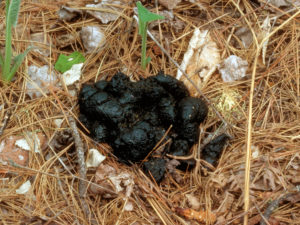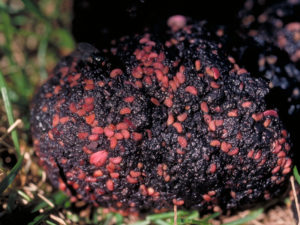Scat / Droppings

Juneberry scat
People are always surprised to find that black bear scats do not have an unpleasant smell if the bears ate only fruit, nuts, acorns, or vegetation. In those cases, the scats smell like a slightly fermented version of whatever the bear ate. Distinctive smells like strawberries come through clearly. Scats that contain meat or garbage smell somewhat foul but nothing like the feces of dogs, cats, or primates.
Scats reveal what bears ate. In addition to the smell, look for seeds, leaf fragments, insect parts, hairs, bone fragments, scales, etc. Match these clues up with items in the area to learn bear diets. Sometimes finding matching items takes close observation. It forces a person to learn details of vein patterns in leaves and exactly what different kinds of seeds or hairs or insects look like. Look under a microscope for more detail.
Black bear scats typically weigh ½ to 1 pound or more. They may be tubular, loose, or watery. Loose or watery scats do not mean the bear is sick—only that the bear was eating moist foods. Scats from succulent vegetation or berries are typically loose. Scats from meat may be watery.
Bear scats don’t hold the contagious microorganisms some carnivore droppings do. Blood tests showed that researchers who had handled bear scats for decades were negative for any of these microorganisms.
Black Bear Scats:
 |
This April scat is made up almost entirely of big-tooth aspen catkins. A 6-year-old female climbed high in the tree and pulled in the branch tips to feed. |
 |
A fresh dropping consisting mostly of vegetation. Bear droppings have different shapes and consistencies depending upon the food eaten. |
 |
This dropping is from a black bear that has been eating mostly vegetation. Air and sun have turned it black. |
 |
Conveniently flattened on a road for easy examination, this dropping is composed almost entirely of wild sarsaparilla seeds. Sarsaparilla droppings can be reddish to dark purple. They differ from blueberry droppings in color and by having flat half-moon-shaped seeds rather than seeds that look like sand. Wild sarsaparilla berries ripen in late July and early August near the middle of the longer blueberry season. Bears prefer sarsaparilla, so often the droppings found at the height of blueberry season are composed mostly of wild sarsaparilla seeds. |
 |
Most of the obvious seeds in this black bear dropping are raspberry, with one chokecherry pit showing. A characteristic of black bear droppings is that they have a pleasant odor when the bear has been eating fruit and/or vegetation. |
 |
An actual blueberry dropping. Blueberry droppings usually include a lot of whole berries that were not soft and ripe enough to be broken up in the bear’s muscular stomach. Bears hardly stop to chew berries. Instead, they swallow them whole and let their muscular stomach grind the pulp off the seeds. The seeds of blueberries are very small and look like sand. |
 |
This late summer scat is made up almost entirely of downy arrowwood berries. Arrowwood berries have a high fat content and are favored by bears. |
 |
Bears often feed heavily on an abundant food source. After washing out dissolvable materials we found this scat was chock-full of hawthorne seeds (inset). |
Black Bear Sign (article list)













